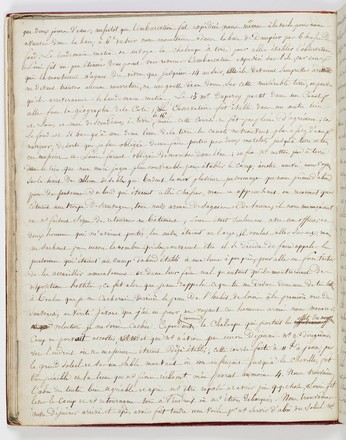Journal particulier de Rose pour Caroline
Rose de Freycinet Journal (September 1817- October 1820)
SAFE / MLMSS 9158 vol 1
Rose de Freycinet was the young wife of French
naval officer Louis de Freycinet. In
1817 Freycinet was given command of a Pacific scientific and exploring
expedition, as captain of the Uranie. The Uranie expedition was one of the major
expeditions into the Pacific in the early 19th century. The expedition sailed,
via the Cape of Good Hope, to Shark Bay, in Western Australia, before sailing
to Timor, Indonesia, the Caroline Islands, and Guam. The expedition then sailed
across to Hawaii, and then south to Sydney where they stayed for a month in
November 1819. They spent time exploring the townships of Sydney and
Parramatta, with some expedition members travelling as far afield as Bathurst.
The expedition left Sydney Cove on Christmas Day, 1819 but on
the 14th of February 1820 the Uranie struck rocks in the Falklands Islands and the ship was
damaged beyond repair. A three-month wait followed, and finally, they secured a
passage to Rio de Janeiro, and reached Le Havre on 13 November 1820.
Rose kept
two records of the expedition. One was her journal, which she wrote expressly
for her dear friend Caroline de Nanteuil, the other was a series of letters
written to her mother during the voyage.
Disguise & Deception
As captain of the Uranie,
Freycinet secretly planned to take with him his 21-year-old wife, Rose, a well
educated and cultured woman. Because this was very much against regulations,
Rose slipped on board dressed as a man, and stayed in her husband’s cabin until
they had cleared Gibraltar. It seems
clear that some of her family were aware of her plans, and there were certainly
well known precedents. Jeanne Baré had slipped aboard Louis-Antoine de Bougainville’s
1766 world expedition. Baré maintained her disguise for much longer than Rose
who only waited a couple of days to reveal her deception.
It would seem that Joseph Banks may have had similar plans to
smuggle a woman on board the Resolution
on Cook’s second voyage. On Cook’s arrival in Madeira he learned that three
months earlier a ‘gentleman’ of the name of Burnett had arrived on the island claiming
that ‘he’ was waiting to join Banks’ party as a botanist, having been unable to
board the ship in England. Shortly before the Resolution’s arrival, ‘he’ (now widely recognised as a woman)
learnt of Banks’ failure to sail and immediately embarked on the first sailing
ship home to Europe. Cook wrote to the Admiralty saying that ‘every part of Mr
Burnett’s behaviour and every action tended to prove that he was a woman. I
have not met with a person that entertains a doubt of a contrary nature … ‘
(Hough, 1994). Perhaps the mysterious ‘Mr Burnett’ was Mr Banks’ mistress and it
is possible that Banks may have had plans to smuggle her on board the Resolution? However this has never been
proven.
Rose’s journal and letters provide a personal perspective to
a major official expedition. They detail personalities and events in contrast
to the official account published by her husband. Rose’s presence on the voyage
of the Uranie could never be
officially acknowledged and although Rose was included in Alphonse Pellion’s
unofficial depiction of the Uranie camp
in Shark Bay, Western Australia, she was removed from the published official
view.
Shipwreck off Falkland Islands
On 14 February 1820, the Uranie
struck rocks in the Falklands group of islands. The ship was damaged beyond
repair. A three-month wait followed, camped on an island and hoping for a
passing ship to rescue them. A passage to Rio de Janeiro was finally secured.
They reached Le Havre on 13 November 1820.
`I thought that it was all over forever for me, I gave my
soul to God and I despaired att eh idea of the dreadful death that we were
going to suffer.'



 Back to list
Back to list